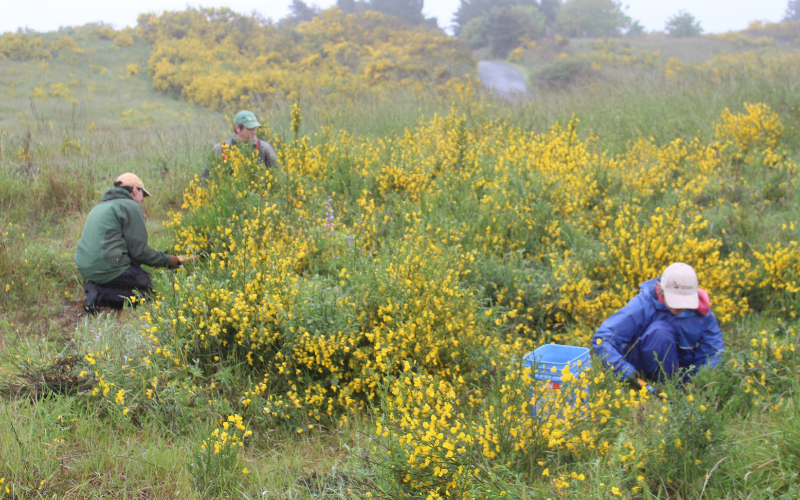
Every May, North Coast Land Conservancy staff works (extra!) hard to remove invasive Scotch broom on the organization’s habitat reserves on the Oregon Coast. With Broom Buster Month coming up, they are looking for volunteers to participate in a variety of work parties.
Widely planted and admired in the early 20th century for its bright yellow blossoms, Scotch broom out-competes native plants. As a result, it is turning open coastal prairies into a monoculture of dense, weedy shrubs, destroying the habitat that many coastal animals need to survive.
During Broom Buster Month, NCLC will be taking two trips to its recently conserved Rainforest Reserve from 9 a.m. to 3 p.m. Wednesday, May 3, and Wednesday, May 24. These work parties will focus on removing Scotch broom that is growing in clearings on this special 3,500-acre preserve— located in the Coast Range between Cannon Beach and Arch Cape—that is characterized by rare and endemic plants.
NCLC also is hosting a Broom Busting on the Prairie work party from 10 a.m. to 1 p.m. Saturday, May 13, at its Surf Pines Habitat Reserve on the Clatsop Plains, just north of Gearhart. To take part in any of these events, sign up at NCLC’s Together in Nature event page.
Additionally, NCLC’s weekly Weed Warrior Wednesday stewardship events in May will focus on a broom-busting project at one of the organization’s habitat reserves. You can learn more about the Weed Warrior Wednesday program and sign up at here.
Removing Scotch Broom at Home
Property owners also are encouraged to remove Scotch broom and other invasive plants from their own properties during Broom Buster Month. Small infestations can be effectively treated with basic hand tools—and a lot of dedication, although the best method of control is dependent on the size of the plant.
For example, Scotch broom plants produce prolific seeds that are extremely long-lived, so if you have large, mature plants in your yard, you are certain to have a good crop of seeds waiting eagerly for some bare soil and disturbance.
For this reason, using a weed wrench to pull out mature plants or a shovel to dig out large plants can actually do more harm than good. The one big plant you kill by ripping it out of the soil makes great habitat for 50 young broomlings to take its place.
A more effective—and easier—way to get rid of a mature Scotch broom plant is simply to cut it (with loppers, a handsaw, or a chainsaw, depending on size) below the photosynthetic stem, or where the stem is at or below ground level and brown and woody, rather than green.
If you cut it too high on the stem, the plant will continue to photosynthesize and will just re-sprout from the existing stem. If you cut the stem down low enough, however, the plant will not re-sprout and the ground will remain undisturbed.
On the other hand, if you have young Scotch broom plants on your property, the best method is to pull them up.
Comments